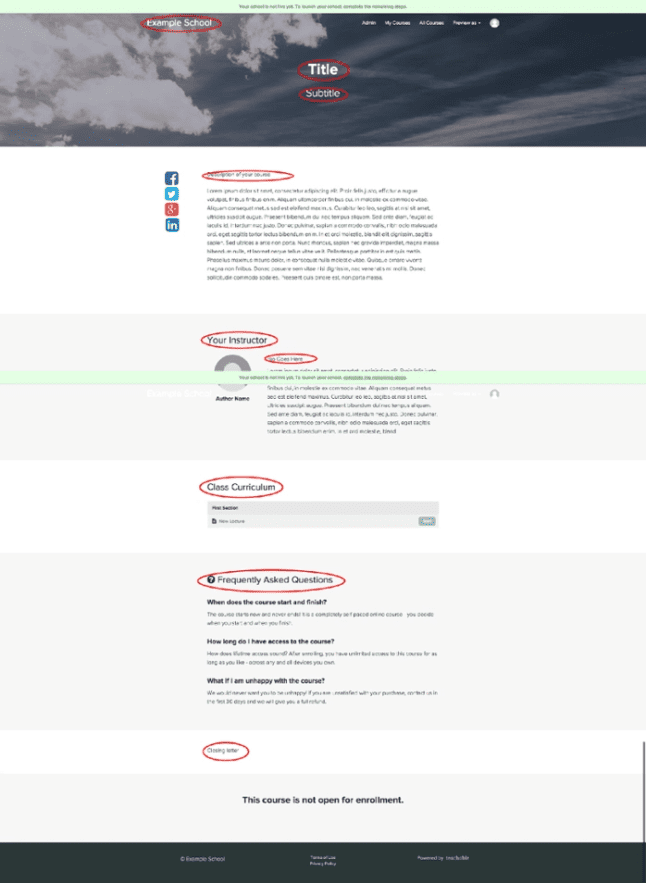Course creators focus so much time and energy creating their course and reaching their audience they often run out of energy where it matters most: sales copy. Your sales page is your biggest opportunity to show your audience why your course is so valuable and transformative. The right sales copy can paint your online course as the solution your students have been looking for and the tool that will solve their problems. What’s more, sales copy that converts is critical in helping you start earning a profit.
What sets sales copy apart
If sales copy intimidates you, you’re not alone. Even skilled bloggers or content marketers have the tendency to get sales copy wrong when they’re just winging it. They write their sales page the same way they write their blog posts or newsletters and hope for the best.
Sales pages are different than the average blog post, though, because they have a different end goal.
When you’re writing a blog post you tend to be aiming to inform, and hopefully gather a few email addresses along the way. With sales copy, on the other hand, you’re hoping to get people to part with their hard earned money and commit to a transformation that you can offer.
That means you need to convey two things: the value of your product and the urgency to enroll now. You start with, “Choose my product because it will make your life easier,” and close with, “But you should hurry because time is limited.”
How to write effective sales copy that converts
You can think of writing sales copy that converts as a step-by-step process which, when executed correctly, can result in increased sales and more income for you.
1. Define your audience
Your course isn’t a perfect one-fit-solution for anyone and everyone. And you shouldn’t advertise it as such. Before you write a line of copy, figure out exactly who your target audience is. Consider these factors:
- Is your course better suited for novices or someone who already knows the basics?
- What is the end goal of taking your online course?
- If you had to describe them, who would your ideal customer be?
- Who is your course not for?
As you answer these questions, a persona will start to emerge. The more specific you can get, the better (Imagine one person, maybe someone you know).
If you know that your target persona is a 55-year-old male who is a first-time entrepreneur honing his business idea., it’s much easier to develop a voice that’s persuasive. You’ll be able to talk about technology and business in a way that makes most sense to him, which will make it a no-brainer for him to take your course. After all, you get him, and he can trust you.
Take a look at how Melyssa Griffin clearly describes who her online course is best fit for and who isn’t right for taking Pinfinite Growth.

Off the bat she says that this course is perfect for bloggers new and old—the strategies in the online course will help anyone looking to grow their traffic and email list. Furthermore, the course is perfect for busy folk who are looking to run their Pinterest on autopilot without having to devote a ton of time or energy to the program.
By making it clear who you’re targeting with your course you accomplish two things:
- You make your target audience feel included when they see themselves in your “who this course is for” section
- You will have less people asking for refunds, because if a potential customer doesn’t fit into your “who this course is for” section they’ll be less likely to buy your course in the first place
2. Make your sales page snackable
Your sales page should be easily scannable and digestible. Your audience is likely to first scan the sales page before diving in so they can see if reading your sales copy is even worth their time in the first place. Divide your sales page into very clear sections divided by images, graphs, and color blocking that clearly differentiate section a from section b from section c.
You can also use plenty of bolded text and colored text to make certain points and statements stand out. Again, this makes the sales page very scannable. Your audience members should be able to take a very quick, 15-second look at your sales page as a whole and already have an idea of whether or not you course is going to be a fit for them. Based on an initial scan, your audience will decide whether they should stick around or if maybe your online course isn’t going to be the best fit for them.
Plus, we need to be honest: People are easily bored and easily distracted. If you don’t have something on your sales page to catch their eye right away they are likely to click to another tab and never think of your sales page again. Learn to customize your sales page here.
Must-have elements for sales page copy that converts
- Use very clear headers – They can be simple (i.e. “Testimonials”) or a bit punchier (i.e. “What people are saying.”) Regardless, including headers will help your audience know what to expect and prompt them to read your page.
- Vary text size and color – Breaking up a wall of text with a variety of text types will make your page easier to read and encourage your audience to stick around and read more.
- Include negative space to make your page easy to read – Negative space is simply the area on your sales page that has no text or images. Adequate negative space keeps your page from looking too busy or overwhelming, and invites your audience to stick around a bit longer.
- Add images to break up the text – Images are going to make your sales page less intimidating. Images also serve to draw the reader’s eye – so make sure the copy surrounding the images is persuasive.
At Teachable we make dividing up your sales page simple. Our default template breaks up the sections for you. And our text editor makes adding heading and different sized text simple.

3. Tell a story
As cliche as it might sound, telling a story on your sales page can really help your audience connect with you and your product. By painting a vivid picture of who can benefit from your product and the problems you’re going to solve, you can help people connect with your product. Start with telling your own story, or sharing a case study of a friend or client you helped.
Describing a clear pain point that your online course is going to solve and then explaining how your course will help your students overcome that pain point is very valuable in creating a powerful sales proposition.
4. Overcome objections
People naturally try to talk themselves out of making any big purchase—whether it’s a new vacuum cleaner that they have a practical need for or an online course that can transform their life or business. You need to nip that tendency in the bud.
Address any rational concerns someone might have when it comes to buying your course, and frame your online course as the best possible solution for the problems that your audience is having.
Common objections
- “This course is expensive.” If you haven’t effectively portrayed the value of your course, people may think of it as expensive rather than valuable. One way to prove the value of your course is with language like, “The information in this course is worth well over $900, but I’m selling it for just $150,” or, “This course will help you earn $1,000, but I’m giving it away for just $150.”
- “I could learn how to do this on my own.” Online courses are a shortcut to an outcome and that’s what you have to emphasize in your copy. Say something like, “It took me two years to master this concept, but I’ll get you to where I am in just three weeks.”
- “Why would I buy from you when _______ is selling a course on the same topic?” A lot of course instructors get a case of “imposter syndrome.” Say something like, “I’ve been where you’ve been, and it wasn’t all that long ago. I remember what you’re going through because I was in your shoes just two years ago.”
- “But how do I know I can trust you?” Chances are you customers have never met you, and you could be anyone hiding behind a fake online identity. Building trust online is a very important component of making sales. One way to build trust is through testimonials. Testimonials show that other people trusted you and are glad that they did.
5. Use clear calls to action
A call to action is exactly what it sounds like: text or an image that’s calling out to your reader to take an action. It can be as simple as “Enroll now!” or a little punchier, “Join the fun and buy today!” It’s easy to worry about being sales-y and opt for softer calls to action, like “Learn More.” But if your copy is doing its job, your future students are looking for a clear button that tells them exactly where to purchase.
So be upfront and ask people to purchase or sign up for your course. That’s why you brought them to your sales page in the first place, and that’s why they’re there.
6. Use benefit-driven language
Benefit-driven language on your sales page that converts. This presents your course to your audience in a way that appeals to them and their needs. Instead of saying, “I’m giving you five hours worth of content that I spent two months creating!” You can say, “After taking this course you’ll be able X which will result in Y and Z.”
Make sure that your sales copy is less about you and more about your audience and your online course.
Here is an example of benefit-driven language from Reach Your Readers by Creativindie.

Benefit-driven language helps people visualize what the outcome of the course will be. In turn, this makes them more excited to buy.
Get inspired
Here are 10 great online voices that use sales copy that converts.
- The Copy Cure – This is free training from Laura Belgray and Marie Forleo brings actionable tips to your inbox.
- Noah Kagan – A marketer who has built his brand on his writing style. His blog OkDork is filled with personality and actionable advice.
- MozBlog – Notice how clean each article is. Some of it is long and detailed, but it’s all there for a reason.
- Contently – Contently is an industry leader publishing articles on content marketing and copy.
- CopyHackers – Joanna Wiebe has some great content you can learn from on how to make your copy compelling.
Join more than 150,000 creators who use Teachable to make a real impact and earn a real income.



.png)





